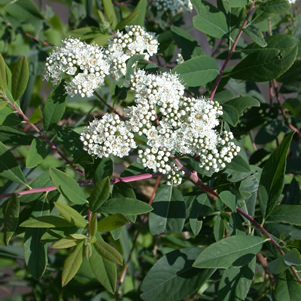Shrubs, 30–40 dm. Stems erect to arching or prostrate, densely branched. Leaves: petiole 2–5 mm; blade ovate to oblanceolate, 3–5 × 1–1.5 cm (length 3 times width), membranous, base acute, margins entire or dentate ?teeth 1–4 in distal 1/4 of blade, mucronate, number of primary and secondary serrations 1 times number of secondary veins (excluding inter-secondary veins)?, venation pinnate cladodromous, secondary veins not prominent, apex acute to acuminate, abaxial surface ?glaucous?, mostly glabrous, adaxial glabrous. Inflorescences mostly terminal, corymbiform or hemispheric panicles, 2–8 × 5–22 cm ?height 0.5–1 times diam.?; branches ?frequently in axils of leaves?, usually glabrous or pubescent, sometimes villous. Pedicels 1–3 mm, usually glabrous or pubescent, sometimes villous. Flowers 5–7 mm diam.; hypanthia turbinate to campanulate, 1.2–1.8 mm, surfaces glabrous or pubescent; sepals triangular, 1–1.2 mm; petals yellowish white, greenish white, or translucent white, ovate to orbiculate, 1.8–2 mm; staminodes 0; stamens 25–45, 2 times petal length. Follicles oblanceoloid, 1.5–2 mm, ?shiny?, glabrous.
More
Simple or sparsely branched shrub to 1 m; lvs oblong-oblanceolate or oblanceolate, 3–6 cm × 10–18 mm, acute and mucronate, entire or with a few low teeth near the tip, somewhat glaucous beneath; infl terminal, compound, short and broad, 3–8 cm wide, the branches glabrous or villous; hypanthium glaucous; fls white, 5–6 mm wide; sep 0.8–1.1 mm; fr 1.5 mm. Damp, rocky banks in the mts.; W.Va. and Va. to Tenn., N.C., and n. Ga.

